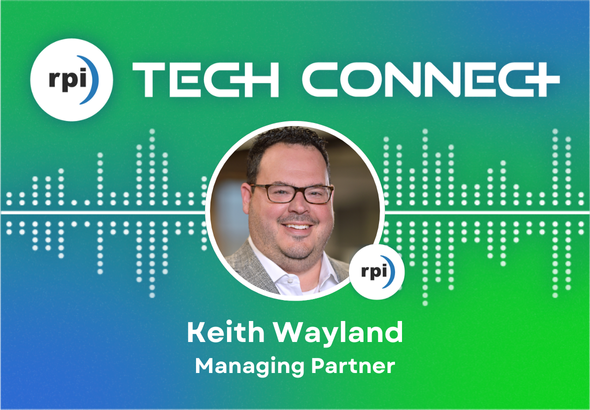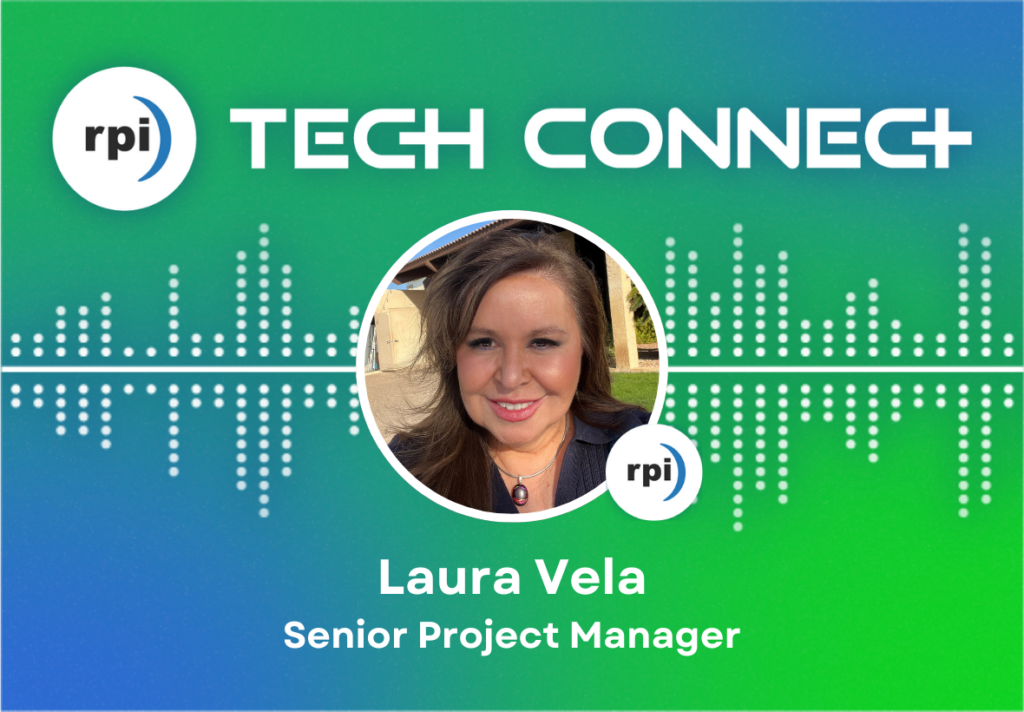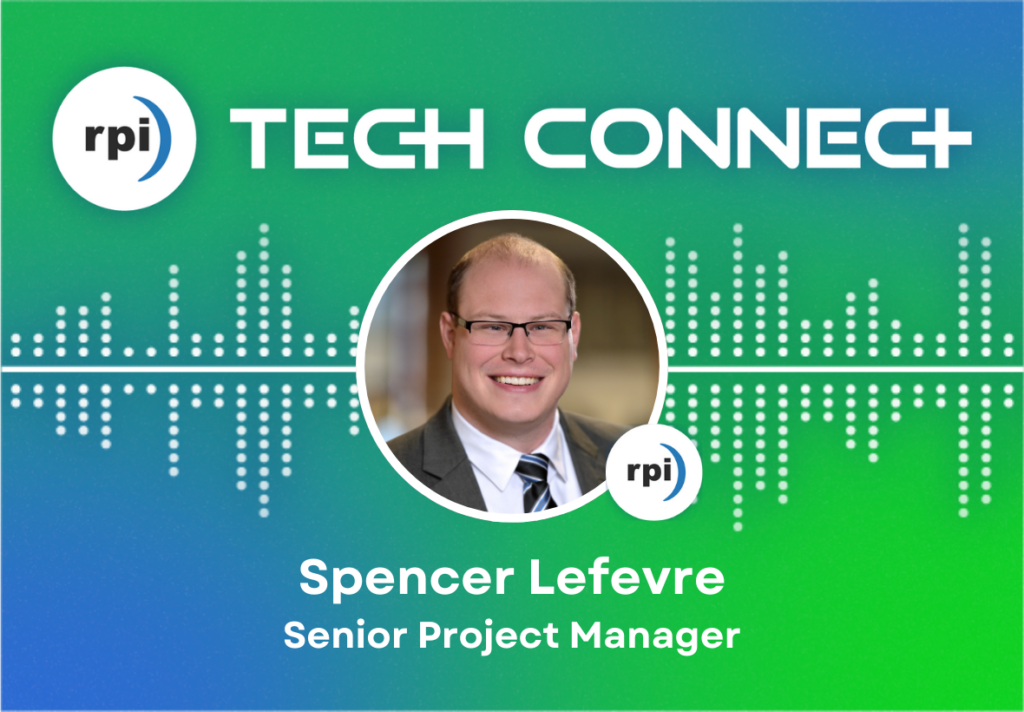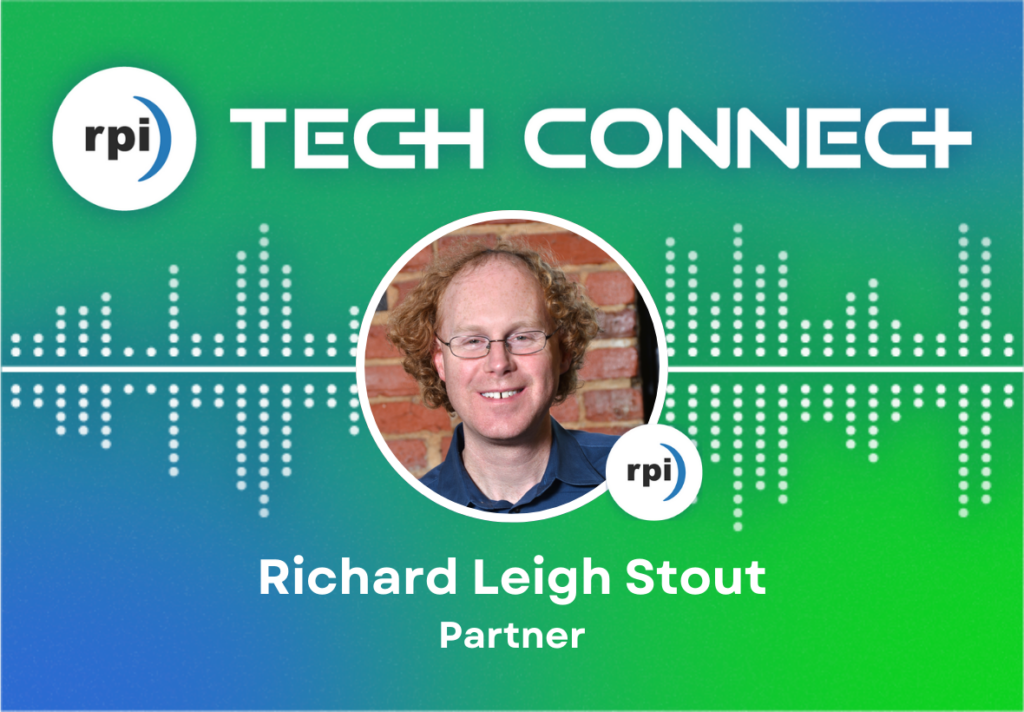The Season 2 debut of RPI Tech Connect kicks off with the highly anticipated annual predictions. RPI’s Managing Partner, Keith Wayland, shares last year’s forecasts and broader ERP trends, before unveiling his top three predictions for Infor ERP in 2025.
From industry-specific ERP adoption to the continued rise of Workforce Management and the game-changing potential of Yoga Software for AP automation, this episode delivers insights and strategies to help you prepare for the year ahead. Plus, Keith offers advice for navigating 2025’s challenges and opportunities. Tune in now to start the new year with clarity and confidence!
Interested in listening to this episode on another streaming platform? Check out our directories or watch the YouTube video below.
Meet Today’s Guest, Keith Wayland
Keith Wayland is the Managing Partner of RPI Consultants, an enterprise consulting firm that specializes in improving business processes through innovative solutions and applications.
Keith co-founded RPI Consultants in 1999 and transitioned to the role of Managing Partner in 2013. Under his guidance, RPI expanded its portfolio of services across the Infor ecosystem, achieved over 400% revenue growth, gained recognition as an industry thought leader, and tripled its employee headcount.
Previously a functional consultant, Keith supported many Lawson implementations across healthcare, public sector, and other industry verticals. This foundation provided him with the hands-on experience needed to deliver successful ERP outcomes to services organizations.
Keith’s leadership philosophy emphasizes collaboration, leading by example, and building trust through transparency. With RPI’s expansive portfolio and commitment to excellence, Keith is dedicated to continuing the company’s trajectory of success for years to come.
Meet Your Host, Chris Arey
Chris Arey is a B2B marketing professional with nearly a decade of experience working in content creation, copywriting, SEO, website architecture, corporate branding, and social media. Beginning his career as an analyst before making a lateral move into marketing, he combines analytical thinking with creative flair—two fundamental qualities required in marketing.
With a Bachelor’s degree in English and certifications from the Digital Marketing Institute and HubSpot, Chris has spearheaded impactful content marketing initiatives, participated in corporate re-branding efforts, and collaborated with celebrity influencers. He has also worked with award-winning PR professionals to create unique, compelling campaigns that drove brand recognition and revenue growth for his previous employers.
Chris’ versatility is highlighted by his experience working across different industries, including HR, Tech, SaaS, and Consulting.
About RPI Tech Connect
RPI Tech Connect is the go-to podcast for catching up on the dynamic world of Enterprise Resource Planning (ERP). Join us as we discuss the future of ERPs, covering everything from best practices and organizational change to seamless cloud migration and optimizing applications. Plus, we’ll share predictions and insights of what to expect in the future world of ERPs.
RPI Tech Connect delivers relevant, valuable information in a digestible format. Through candid, genuine conversations and stories from the world of consulting, we aim to provide actionable steps to help you elevate your organization’s ERP. Whether you’re a seasoned professional or new to the ERP scene, our podcast ensures you’re well-equipped for success.
Tune in as we explore tips and tricks in the field of ERP consulting each week and subscribe to RPI Tech Connect below.
Transcript
Chris Arey
The future is uncertain, but history often provides clues. In the annual predictions episode, we reveal three bold bets for Infor in 2025, as well as their impact on the community.
Chris Arey
Welcome to season two of RPI Tech Connect. I’m your host, Chris Arey, and I’m pleased to share that going forward, we’re going to be shooting these discussions in video. Once again, I’m going to be exploring best practices, developments, and trends throughout the Infor community and greater landscape.
Today, we’re kicking things off in style. It’s a very special episode; our annual predictions tradition, and who better to join us than the man who started it all. Please join me in welcoming back Mr. Keith Wayland, managing partner of RPI Consultants.
Keith Wayland
Thank you very much, Chris. It’s a pleasure to be here. Really, really impressed with the work you’ve done so far on this podcast. I must say, it’s pretty intimidating. You have a perfect podcasting voice and cadence, and I will do my best to not bring you down.
Chris Arey
Thank you, sir. I appreciate the compliment. Really excited about where this podcast program is going and excited to kick off the new year with this fantastic episode. Before we get into our predictions for 2025, I thought it’d be good to reflect on what we predicted last year.
I know one of the big ones there was we thought that Infor was going to prioritize partner-centric ecosystems along with focusing on some product improvements. And of course, the rise in workforce management as a market. Fast forward a year, here we are. How did things pan out from your perspective?
Keith Wayland
Well, let’s just start by saying I’m glad those were our predictions because they largely became true. Not only did Infor put a lot of emphasis on fleshing out its global partner ecosystem with a focus on the U.S., but they committed to creating better bidirectional relationships, getting feedback, and working with our partners.
It’s a very exciting time because it allows both of us to deliver better solutions for our customers. Of course, you know, it’s an ongoing thing. It’s not like a checkbox- we did this, and we moved on; it’s something we’re excited to continue.
I’d like to say that partnerships are about relationships. In large companies, they’re about having a large number of relationships, trust, and transparency. However, they’re also about the attitude towards partners in general. All those things have been very positive and on the upswing. It’s been a good year, both for us and for the partner community.
As far as product, I think Infor has come a long way over the years and their solution is second to none right now. We’re excited to go out there and show everyone that. As for the third point you mentioned, WFM market growth last year was explosive in nature. This is something that’s poised to continue, I think, just based on the market opportunity that’s out there.
Chris Arey
Awesome. I think it’s always good to look back and kind of see where we came from. I appreciate you sharing those details, and now with that little recap there, we can talk.
Keith Wayland
Yeah. Now I’m worried because it’s as though I’m going to have to be held accountable for whatever I say today, a year from now.
Chris Arey
You’ve got a good track record I have to say, so we’ll be rolling with the punches here a year from now saying you know what? All that came true again. Now, I’ve heard you talk about different ways of moving to the cloud from an industry perspective. What exactly do you mean by that? Could you please expand on what you’re thinking there?
Keith Wayland
Yes, thank you, Chris. I think we’re about to enter a third wave in CloudSuite migrations. But before I get into that, I think I need to give a little bit of context about the space that we’re in, because when you look at Infor’s strategy, it is to deliver industry-specific and focused solutions. The market that we play a part in, and we pay attention to, is called the services industry.
In that services industry, there’s a whole variety of different categories, but the two biggest are health care and public sector. The health care wave started quite some time ago, towards the beginning of these modern SaaS cloud solutions.
A lot of the health care industry was coming off of very large EMR investments, encouraged originally by the Affordable Care Act, and they moved right into modernizing their ERP and back-office applications. That wave is still ongoing, but I would say it peaked probably in the 2022, 2023 timeframe.
The second wave took place in what we tend to refer to as the public sector, which includes city & county governments, states, K-12 educational facilities, utilities, and transit authorities. And you know, they’re a little bit more deliberate in their procurement process and their planning. Right? So the process to say: “I’m going to move to an ERP” could be three years. Right? And even though each one of these has different regulations that they follow, how that process plays out is public. That’s still ongoing, but right now we’re living in that peak, whereas three years ago, around 70 % of the market that was transitioning plus was healthcare.
Now, the public sector might not quite be that 70%, but it’s close to it. It’s the dominant player. Those are the first two waves, and now for the third wave, which is essentially this long tail of other industries that fall under the service umbrella. This includes businesses that provide financial services & assisted living along with freight companies and casinos.
Keith Wayland
So, as a result, there’s a whole other set that is now getting started in earnest that I think is going to be the cause of a lot of the traction that we see not only in 2025, but in 2026 as well.
Chris Arey
Very cool. And these different sectors all have different needs for how they approach moving to the cloud. I think you alluded to that a little bit there.
Keith Wayland
Absolutely. I think that they have, they have different footprints a little bit, you know, they all do. In healthcare, HR was front and center; resources, retention, recruiting, development, they’re all very important. In some of our public sector clients, we see a little bit less turnover. There are some demographics that must be worked through in the next decade, but a lot of the focus is on financial controls and transparency, right? They’re publicly accountable to their constituents.
Chris Arey
That makes sense.
Keith Wayland
When we look at these new industries, they’re going to be more for-profit business oriented. In some instances, they might be nimbler. We’re certainly seeing that during the procurement process. And their needs are going to be more nuanced- they’re going to have more AR & billing requirements, while in healthcare, they can use EMR for those functions.
They’re going to have businesses outside of the US, meaning you’re going to see more multi-currency and a more fleshed out finance functionality. And, you know, I think the most exciting thing to me is that we’re system implementers, but we’re always curious about our organizations.
Knowing the business that they’re in and then understanding how they operate and run it. Understanding how they get supplies, manage their people, and then take care of their finances and reporting requirements. And, you know, I think it’s fun for our team to get a chance to learn some new businesses.
Chris Arey
Yeah, yeah, very cool. It’s really interesting to see too how Infor has created an ERP that supports these different organizations despite the different industries that they work in. That speaks volumes, I think, about the product itself.
And it’s something that I know that they really dialed in on this past year at Velocity and Connect, speaking about their focus on industry specificity and how the application is always being optimized to better support their needs.
Keith Wayland
I mean, I believe there are two elements. The first is foundational for these diverse services industries, and that is a very flexible general ledger, right? The ability to capture your financial information in different ways that fit different needs and to be able to report on it. I think that in the end, it acts as the foundation of the entire system.
The other is Infor is investing very heavily in its technology, specifically its operating systems and in AI, right? They’re also trying to create tools that they can use. The third thing that I think has been important over the years but is sometimes understated is the fact that Infor has always been very focused on extensibility, right? Part of being industry targeting is acknowledging that there are nuances between companies.
Some of the competitors out there present a product that is very “out of the box, take it or leave it”. With Infor, you have a certain level of customization, and they pay very special attention to building a SaaS platform that allows you to do that.
Chris Arey
Awesome. Yeah. So, okay. That’s our prediction number one. We anticipate this expansion, this new wave into the niche financial services industry going forward.
Now we’ll pivot and we’ll talk about prediction number two, which I think is tied to something you had forecasted last year: this notion of continuing expansion and workforce management. We saw growth last year. What do you anticipate for 2025?
Keith Wayland
Absolutely. You know, I think there’s a lot of market opportunity out there and I think it’s going to continue to grow and gain traction. You know, WFM, at least in the spaces of the service industry, specifically healthcare and public sector, is a market disruptor, right? It’s the new kid in town and it’s having a lot of success because this solution, even though it’s a new kid in town, has been developed over 20 years, right? With very specific targeted niche functionality that is important to these industries.
Chris Arey
Okay, so I’ve heard from various folks at RPI and actually from those at Infor and beyond, you know, it’s becoming a more dominant player in the WFM space. What role is RPI playing in this expansion of the WFM market?
Keith Wayland
Well, absolutely. I think when you have the solution that’s fleshed out, but maybe doesn’t have the level of visibility or maybe history in some of these industries, it’s about communicating that message out, right?
Making that information accessible, showing people what that solution looks like, making sure that there are customers out there sharing their experiences and implementing and using it.
So, you know, I do think that we have a role as educators, if you will. This is what the market has to offer. And maybe it’s for you, maybe it’s not, but you should at least be aware of like, here’s some very good alternatives for you.
Chris Arey
I’ve heard that Infor WFM is a great solution if you’re already in that ecosystem, given the way that it interacts with the various other applications like FSM and HTM. It’s a seamless experience from what I’ve heard.
Keith Wayland
Yeah, absolutely. I think that’s one of the key values that Infor brings to the table as a software company that is purposely building these programs to integrate. Again, because of their industry-centric focus, they have spent a lot of time and effort to ensure their scheduling systems can handle healthcare, public sector, things like police and fire, some of the more complex scheduling that’s out there. They’re focused on and making sure that their solutions can support and sustain.
Chris Arey
Very cool. I hope to see more growth this year and beyond too. It’s an exciting time. Yeah. Okay. So now time for the big reveal prediction number three. You know, so many organizations are now live on the Cloud and are having a good experience, but what’s going to help them get the most impact out of that system going forward. What do you see there?
Keith Wayland
Been exciting, yeah. I think that you’re in for a great journey once you’re on Infor CloudSuite. Not only is there a ton of functionality to be leveraged, but we also always advocate continuous improvement.
You can’t roll it out all at once. You need to do it according to your organization’s ability to absorb support and level of change-hardiness. On top of that, you have Infor constantly at the forefront, releasing new functionality and features. As I said earlier, there’s been a big focus on AI and machine learning.
But I think what’s going to gain a lot of traction in 2025 is going to be something that’s very close to home, which is a Yoga for AP solution. This is essentially a complementary bolt-on purpose built for Infor FSM that helps automate the AP process. And you know, it’s been incredible. I’ve been in this space for 25 years and I’ve been working with AP automation for 25 years. Over the last three or four years, our team has made more advancement than I’ve seen since the early 2000s. And the results have been really astounding.
I say that because though it might sound self-serving, you can talk to our customers, they’re loving this. They’re gaining true operational efficiencies that are changing the way they process their payables. And this is not just OCR, it’s also capturing EDI, it’s capturing line uploads, and significantly improving the user experience. And so, when I see all these customers that are gushing about it constantly to us and to others, I know that this is having an impact. It’s really reached that point where it’s just going to spread like wildfire throughout the Infor FSM community.
Chris Arey
Very cool. Yeah. It’s always nice to hear from, from clients using the application, how awesome it’s been and the difference it’s making in the way that they carry out their jobs. Speaking of Yoga though, that interacts really well with CloudSuite too, right?
Keith Wayland
It’s purpose built. Yeah. So, I think, when you look at what is a very crowded market, there’s a lot of duplication out there. Yoga doesn’t duplicate any features that Infor has, it simply complements them. right?
So, when you’re importing this data, you’re doing it straight into Infor, you don’t have to go somewhere else to get your accruals. Instead, you leverage the Infor accruals that you’re already using and maintaining. It’s a very, very specific market, which gives them a pretty big leg up.
Chris Arey
Nice. Well, thank you for sharing those predictions. You know, as last year, as we’re looking at what happened over the last year and those things coming through, I think it’s safe to say that you have a crystal ball for telling the future. And I look forward to having this chat with you again next year, but I have one more question for you here: are the Ravens going to the Super Bowl?
Keith Wayland
Wow, that’s a tough question. I certainly hope so. One thing that I will say about the Ravens is that on any given Sunday, they can beat anyone. And they’re an amazing team. I think it’s Bill Belichick that said their biggest enemy is themselves, right? So hopefully they can go on a run here and maybe bring home the Super Bowl.
Chris Arey
If we look back a month after this and see that they won, man, I’m doubling down on you with the crystal ball.
Keith Wayland
Now hopefully I didn’t jinx them.
Chris Arey
Okay, cool. Well, we’re getting close to time. And as you remember, before we wrap up, I’d to ask my guests if they could pass on one piece of advice for the audience today regarding our topic, what would it be? So, I’d love to hear what you have to share there for the people listening.
Keith Wayland
You know, it’s interesting. I read a quote this year from Apple CEO, Tim Cook, that read “not necessarily first, but better”. And you know, right now at RPI, we’re like everyone else. We’re watching all the stuff going on with AI, with machine learning, and these are very exciting times. There’s a lot that’s out there, there’s a lot to consume. There’s a certain mindset of trying to anticipate what the big things are going to be.
But you know, that’s challenging. Some people will figure it out. Some of us might not. What’s important is to pay attention to what gains traction in the market, right? It’ll become self-evident and you don’t have to be there before everyone else.
You just have to make sure you line up when those things start to make a huge impact, right? So, I guess my advice would be don’t overthink it. Just pay attention.
Chris Arey
Yeah, that’s awesome. No, it’s something that sometimes, especially with all the noise that’s out there right now, it’s tough to really dial in, but I agree with you.
Keith Wayland
And it can feel overwhelming. It can feel overwhelming. But at the end of the day, a lot of these things will shake out and the true winners will start to emerge. Those are the places you want to spend your time and effort.
Chris Arey
Awesome. Well, thank you for sharing that, Keith. It’s always a pleasure to have you on the program here. I look forward to having this chat with you again in another year. For our listeners, we appreciate you stopping by and hanging out with us.
It’s a very special episode of RPI Tech Connect. If you have any questions or comments about our segment today, feel free to contact us at podcast@rpic.com. Again, that’s podcast@rpic.com. Until next time, this is RPI Tech Connect. Take care.
Keith Wayland
Thank you, Chris. Really appreciate the opportunity. Love the video concept, love the background, and I wish you a great year on this podcast.
Chris Arey
Thank you, sir.




